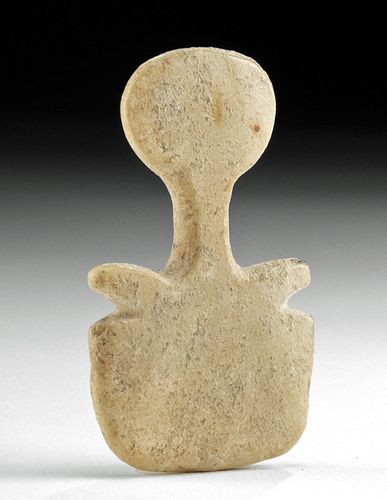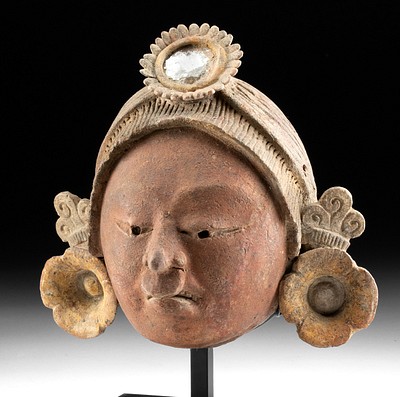Ancient Anatolian Kusura Beycesultan Marble Idol
Lot 49
About Seller
Artemis Gallery
686 S Taylor Ave, Ste 106
Louisville, CO 80027
United States
Selling antiquities, ancient and ethnographic art online since 1993, Artemis Gallery specializes in Classical Antiquities (Egyptian, Greek, Roman, Near Eastern), Asian, Pre-Columbian, African / Tribal / Oceanographic art. Our extensive inventory includes pottery, stone, metal, wood, glass and textil...Read more
Estimate:
$2,400 - $3,600
Absentee vs Live bid
Two ways to bid:
- Leave a max absentee bid and the platform will bid on your behalf up to your maximum bid during the live auction.
- Bid live during the auction and your bids will be submitted real-time to the auctioneer.
Bid Increments
| Price | Bid Increment |
|---|---|
| $0 | $25 |
| $300 | $50 |
| $1,000 | $100 |
| $2,000 | $250 |
| $5,000 | $500 |
| $10,000 | $1,000 |
| $20,000 | $2,500 |
| $50,000 | $5,000 |
| $100,000 | $10,000 |
| $200,000 | $20,000 |
About Auction
By Artemis Gallery
Jul 14, 2022
Set Reminder
2022-07-14 10:00:00
2022-07-14 10:00:00
America/New_York
Bidsquare
Bidsquare : Exceptional Antiquities Ethnographica Fine Art
https://www.bidsquare.com/auctions/artemis-gallery/exceptional-antiquities-ethnographica-fine-art-9692
Museum-worthy examples of classical antiquities (Egyptian, Greek, Roman, Near Eastern), Viking, Far East / Asian, Pre-Columbian, African / Tribal, Oceanic, Native American, Spanish Colonial, Fossils, Ancient Jewelry, Fine / Visual Arts, so much more! Artemis Gallery info@artemisgallery.com
Museum-worthy examples of classical antiquities (Egyptian, Greek, Roman, Near Eastern), Viking, Far East / Asian, Pre-Columbian, African / Tribal, Oceanic, Native American, Spanish Colonial, Fossils, Ancient Jewelry, Fine / Visual Arts, so much more! Artemis Gallery info@artemisgallery.com
- Lot Description
Ancient Near East, Anatolia, Early Bronze Age II-III, ca. 2700 to 2000 BCE. A hand-carved marble idol of attractive and characteristically abstract form with a broad, semicircular body, carved notches beneath a pair of petite arms, a gently corseted neckline, and an ovoid, paddle-shaped head. Idols like this example are referred to as "violin idols" due to their resemblance to the stringed instrument. The meaning and function of Anatolian idols remains an enigma without any written record from this era. Archaeologists have theorized that fertility was prized by these peoples and that the violin idol takes inspiration from the female anatomy, though no doubt interpreted in a highly abstract manner. Size: 1.5" W x 2.375" H (3.8 cm x 6 cm)
Cf. "Idols: The Beginning of Abstract Form." Ariadne Galleries, Inc., New York, 1989, p. 63, fig. 28
Provenance: ex-Nancy and Dr. E.F. Simpson collection, Los Angeles, California, USA, acquired from 1970 to 2000
All items legal to buy/sell under U.S. Statute covering cultural patrimony Code 2600, CHAPTER 14, and are guaranteed to be as described or your money back.
A Certificate of Authenticity will accompany all winning bids.
PLEASE NOTE: Due to recent increases of shipments being seized by Australian & German customs (even for items with pre-UNESCO provenance), we will no longer ship most antiquities and ancient Chinese art to Australia & Germany. For categories of items that are acceptable to ship to Australia or Germany, please contact us directly or work with your local customs brokerage firm.
Display stands not described as included/custom in the item description are for photography purposes only and will not be included with the item upon shipping.
#172262Minor abrasions to body and head, with very small nicks to peripheries, otherwise intact and excellent. Nice surface smoothness along obverse, and good remains of original surface texture along verso.Condition
- Shipping Info
-
All shipping is handled in-house for your convenience. Your invoice from Artemis Gallery will include shipping calculation instructions. If in doubt, please inquire BEFORE bidding for estimated shipping costs for individual items.
-
- Buyer's Premium



 EUR
EUR CAD
CAD AUD
AUD GBP
GBP MXN
MXN HKD
HKD CNY
CNY MYR
MYR SEK
SEK SGD
SGD CHF
CHF THB
THB













